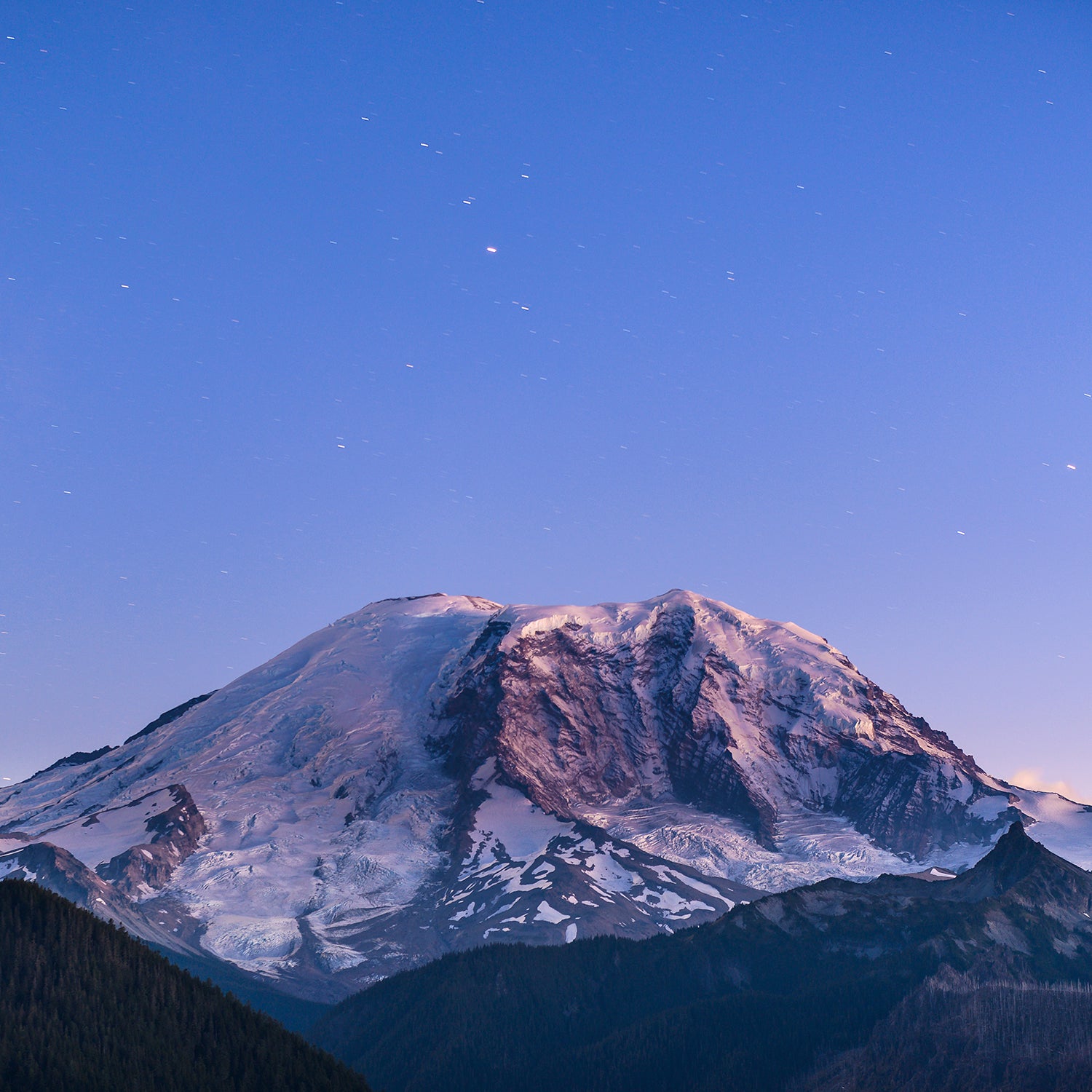Last week, the three commercial guiding companies on Washington’s 14,411-foot Mount Rainier did something they’d never done before: canceled the climbing season outright with weeks left to go. Stormy weather routinely thwarts summit climbs throughout the season, but this was different. It’s way too hot, and has been for months.
More than 10,000 people try for the summit of Rainier every year, about 60 percent of whom are guided. From May 1 to September 30, (RMI), (AAI), and (IMG) run daily sold out trips—at least that’s how it’s been for decades. But this season was an unwelcome indication of what the future might bring.
An uncommonly warm, dry spring and a blistering summer decimated the snowpack in the Cascades, the lower 48’s most glaciated range. For the first time that anyone can remember, the entire summit of Mount Baker melted down to dirt. Guides had to constantly adjust Rainier’s heavily trafficked Disappointment Cleaver route to contend with rockfall and snowmelt on the Cleaver itself (its namesake crumbling, rocky ridge, which is used by climbers to avoid the glaciers that flank it). Finally, in early September, the guide services determined there was no longer a client-friendly way to the top.
For many guides, it was the worst season they can remember. “There have been years where the route was a problem,” says Dave Hahn, an RMI guide who’s been working on Rainier, Everest, and Denali for 35 years. “But I can’t think of something like this happening before.”
Washington had a solid winter: by the end of March, statewide snowpack was at 131 percent of normal. But the high alpine relies on monster storms in April and May, which come in warm and plaster the highest elevations with snow. This year, those storms never materialized. June finally brought some precipitation, but the temperatures quickly spiked and it rained, everywhere—including on the 10,781-foot summit of Mount Baker, for three days straight.
Then, in late June, the Pacific Northwest experienced a historic heat wave. Temperatures in Seattle hit 108 degrees, power cables melted, roads buckled, and over 500 people died across the Pacific Northwest and British Columbia. Camp Muir, a snowy high camp at 10,188 feet on Rainier, reached a staggering 66 degrees, and the mountain lost 30 percent of its snowpack during the heat event alone.
An unprecedentedly long warm spell followed, says Jonathon Spitzer, Director of Field Operations at AAI and an IFMGA guide who has worked on Rainier for two decades. By mid-July, the mountain looked like it usually does in mid-September: widespread bare rock, rapidly receding snow lines, and exposed glacial ice. Guides were seeing all the telltale signs that the climbing season was coming to a close—but it should have been barely halfway over.
A second heatwave in August brought with it more pronounced hazards than guides were comfortable taking on—including a bus-sized boulder that broke off and swept the climbing path. All commercial operations halted until the temperatures cooled again, and the guides set about establishing a new, more protected route. For about two weeks it was business as usual. But late August and early September stayed hot, and rockfall wiped out the just-established path. For the first time, guides could not find a way up the mountain that they could comfortably bill as a beginner/intermediate excursion.
“You can climb anything with a lot of ladders and a lot of work, but there’s not a safe way or a viable product to offer right now,” Spitzer says. “The glacier is too broken.”
The weather events that led to this challenging climbing season will persist and worsen with climate change, leaving some guides wondering about the future of climbing in the range. A shorter season means less income and a smaller window of employment for guides, and fewer opportunities to climb for clients.
“Just like we adjust our guiding techniques in the field, we might need to adjust our climbing season,” Spitzer says. Both Hahn and Spitzer say that in the Alps, where heat waves are more common, guides are used to pausing for a few days to wait out increased objective hazard due to heat. But that’s not common in the Pacific Northwest, at least not yet.
“We’re still trying to work in an older model of guiding Rainier where the season dependably goes through September,” says Hahn. “But it’s really clear that things have changed.”
A guide with eight years of experience on the mountain, who asked to remain anonymous, had planned to stack trips in the Cascades until September. But by early July he was no longer comfortable with the level of risk he was taking on to guide clients up Rainier. A refrigerator-sized ice block buzzed him in a spot along the Kautz (a more technical route on the mountain) that he had previously considered protected from hangfire. Another guide friend of his developed newfound insomnia the night before summit climbs. Working on the mountain no longer felt worth it to him. So in early July, he quit for the summer. He’ll guide the Disappointment Cleaver again next season if he feels like conditions are reasonable, but he’s done guiding the Kautz for good.
“These Cascade volcanoes are climbable because of the glaciers and snow that encapsulate really shitty ice and rock,” he says. “With the snow melting and glaciers receding, it exposes rock and ice that no one would climb in their right mind.”
People ask Dave Hahn all the time if he’s seen any signs of climate change during his years on the mountain. “The answer is so obviously yes,” he says. “If people knew how far back the snow and ice have melted, and what incredible volume of ice Mount Rainier is losing every year, oh man. It’s amazing that we can still cobble together a fun climbing season, but we do.”
The issue goes far beyond preserving classic climbing routes and guiding jobs, though. Glaciers store water, and Washington’s hundreds of glaciers release 230 billion gallons per year, providing water for its own residents and those of Oregon, Idaho, and Montana—some 25 percent of the region’s summer water supply.
One-third of all the glaciers in the lower 48 are in the North Cascades, and all of them are retreating. Glaciers depend on more snow falling in the winter than melts in the summer—that snowpack protects the glacial ice from summer temperatures. And while this winter delivered an above average snowpack, it still wasn’t enough to fend off the heat.
“It’s going to take multiple big snow years and multiple cool summers for the mountain to recover from what took place this season,” says Spitzer. But with climate change, that trajectory seems unlikely. “When I pause and think to myself how much vertical loss has happened in the last 20 years, it’s scary. You know, I have a kid. What’s going to happen in his lifetime?


